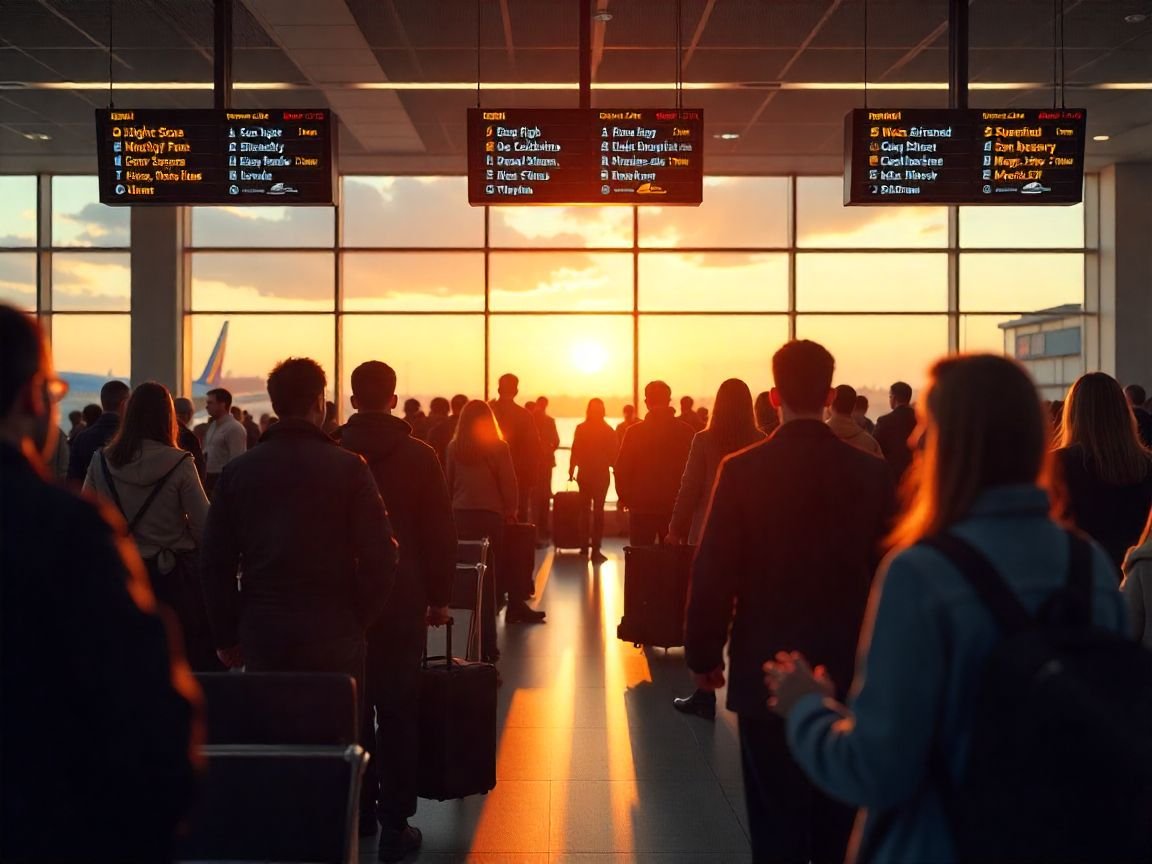Flight Buzz
UAE-Bound Flights Surge After August 15: Save by Returning Early

Thursday, July 31, 2025
Airfares to the UAE from various countries like India, Pakistan, Europe, and the Middle East have seen a significant increase following August 15. In some cases, ticket prices have even doubled. Travel experts have attributed this sudden surge in airfares to the end of the school holidays, which triggers a rush of families and students heading back to the UAE for the new academic year. Those who had not booked their return tickets in advance are now faced with the challenge of either paying higher fares or finding alternative options to get home.
The Reason Behind the Sudden Surge in Airfares
According to travel consultants, the period leading up to mid-August offers relatively affordable flight options. However, once August 15 passes, fares increase by more than 100 percent. The rising demand for flights is primarily driven by the impending school year. Many families and students are making the journey back to the UAE to prepare for the start of classes, which commence on August 25. This sharp rise in fares is most evident on routes from Indian cities, as well as from other regional hubs.
Safiya Javed, a senior travel consultant at Travel Track, shared that airfares from India begin to rise steeply after August 15. Families residing in the UAE prefer to return early to avoid last-minute price hikes and ensure they are prepared for the new academic year. According to Safiya, this trend is observable across almost all flight sectors, but it is particularly noticeable in the Indian market. She pointed out that the average fare from India currently stands at approximately Dh1,000, but this can increase to as high as Dh2,000, depending on seat availability after mid-August. For those returning during the first two weeks of August, the average fare is around Dh600, a difference that can save a family of four more than Dh2,200 compared to booking flights post-August 15.
Bharath Aidasani, managing partner at Pluto Travels, also confirmed that booking flights for the first or second week of August is still relatively affordable. However, fares rise substantially after that. Many travelers have already made their bookings to avoid higher prices later on. Pavan Poojary, a travel consultant at Luxury Travels, emphasized that travelers who delay their bookings are likely to pay much higher prices and face fewer flight options. As a result, many residents who had been staying longer in their home countries are now rushing to return before ticket prices become unaffordable. The surge in prices is real, and so is the scramble to book earlier flights.
Current Fares vs. the Post-August 15 Surge
Flight search engine Skyscanner reported that current one-way airfares from Indian cities like Delhi and Bengaluru to the UAE range from Dh420 to Dh450. Similar prices can be found from other nearby cities, with flights from Cairo to Dubai priced between Dh400 and Dh410, flights from Beirut to Abu Dhabi between Dh245 and Dh325, and flights from Amman to Dubai between Dh365 and Dh445.
For longer-haul destinations, flights from London are priced around Dh1,500 to Dh2,500 for a direct flight. For flights originating from Beijing, fares start at approximately Dh1,181.
However, once mid-August arrives, these fares will increase sharply. For example, fares from Indian and regional origins may rise by over 100 percent, reaching Dh900 to Dh1,500, while longer-haul routes could see prices climb from Dh1,500 to more than Dh2,500, depending on demand and seat availability.
Factors Contributing to the Steep Rise in Airfares
The primary reason behind this significant increase in flight prices is the high demand for tickets following the end of school holidays. Many families and students are rushing to return to the UAE, filling up flights to capacity. Airlines are operating at full capacity, leaving few available seats for late bookings. As Aidasani pointed out, the surge is largely driven by vacation travel, with business travel remaining relatively minimal. The volume of residents returning to the UAE during this time is expected to be substantial.
Pavan Poojary also noted that travelers who delay booking their flights risk facing higher prices and fewer available seats. To avoid this, many families are opting to return earlier than planned, well before the start of the school year. Some even choose to extend their holidays into September, as the difference in fares can be too large to justify a mid-August return.
Tips for Travelers Looking to Save on Flights
For residents who are planning to return to the UAE from countries such as India, it is highly recommended to book flights before mid-August. This allows travelers to save money and reduce the stress of last-minute bookings. Safiya Javed suggested that families traveling before mid-August will avoid the last-minute price hikes and enjoy a smoother return process.
For those who have not booked yet, it is important to make travel arrangements as soon as possible. The first week of August is considered the best window to secure affordable tickets before the demand spikes and prices soar.
Pavan Poojary recommended that travelers who are unable to travel early should remain flexible with their travel dates. Keeping an eye on flight deals and being open to flexible travel dates can help find better prices. This flexibility could prove invaluable, as prices can fluctuate significantly depending on the availability of seats and the level of demand.
For those looking to extend their stay until September, Safiya suggested returning during the first 10 days of August in order to prepare for the upcoming academic year. Booking flights within this window can help mitigate the surge in airfares that typically occurs after mid-August.
In conclusion, UAE-bound flights are expected to become considerably more expensive after mid-August due to the end of school holidays and the influx of families and students returning to the UAE for the new school year. Travelers who are able to book their flights before August 15 stand to save a significant amount of money. For families with children, this early return could result in savings of over Dh2,200, making it worth considering the potential benefits of planning ahead.
While some residents may have already missed the window for affordable fares, others still have a chance to secure lower prices by booking their flights soon. Remaining flexible with travel dates and keeping an eye on potential flight deals can also help to reduce the financial burden of last-minute bookings.
Travel experts emphasize the importance of planning early to avoid the surge in fares. Those returning to the UAE for the school year can significantly reduce their travel costs by taking advantage of affordable flight options available in the first two weeks of August.
Flight Buzz
Southwest Airlines Apologizes After Brief System Failure Grounds Departing Flights, Update You Need to Know

Monday, August 4, 2025
On July 31, Southwest Airlines faced an unexpected disruption that led to the grounding of all departing flights for several hours. The temporary halt was caused by a brief system failure, which affected the airline’s communication network. As a result, passengers experienced widespread delays and cancellations. Here is everything travelers need to know about the incident.
What Happened to Southwest Airlines?
The disruption began when Southwest Airlines encountered a communications issue that impacted its dispatching and operations systems. This malfunction caused the airline to halt all departing flights. A statement from Southwest confirmed the technical issue, clarifying that the airline’s departure process was temporarily suspended due to the brief outage.
The airline worked quickly to restore normal operations, with departures resuming shortly after the issue was resolved around 2 p.m. ET. Southwest Airlines assured customers that nothing was more important to them than the safety of their passengers and employees.
Impact on Passengers
Although Southwest Airlines informed passengers about the delay, confusion arose as the departure boards did not accurately reflect the status of flights. Travelers were presented with both original and revised departure times, making it difficult for them to determine whether their flights had been delayed or canceled.
In response to the confusion, Southwest Airlines spokesperson Lynn Lunford apologized to passengers, emphasizing that the airline’s primary focus was on ensuring the safety and satisfaction of their guests. She assured that the airline would continue to work diligently to minimize the impact of the disruptions.
The airline’s efforts to resolve the situation allowed for a resumption of services, but not without causing significant delays. Around 40 percent of Southwest flights were delayed and approximately 2 percent of flights were canceled due to the severe weather conditions affecting parts of the Northeast.
Broader Aviation Industry Impact
Southwest Airlines was not alone in facing disruptions. The broader aviation industry also experienced significant delays and cancellations on July 31. By 10 am on August 1, more than 600 flights were canceled nationwide and over 2,100 flights were delayed across various U.S. airports. The impact of weather conditions in the Northeast and the Southwest Airlines system failure contributed to this disruption.
The incident also highlighted the importance of reliable communication systems for airline operations. Such disruptions, although rare, have a far-reaching effect on the entire travel experience. Passengers are often left stranded in airports with limited information, which can lead to frustration and confusion.
What Should Passengers Do in Similar Situations?
In the event of a disruption like the one experienced by Southwest Airlines, it is important for travelers to stay informed. Airlines typically provide updates via their official websites, mobile apps and social media platforms. It is recommended that passengers check their flight status regularly and contact the airline if there are any concerns about delays or cancellations.
Additionally, passengers are advised to understand their rights in such situations. In the U.S., the Department of Transportation (DOT) ensures that airlines provide compensation for certain delays and cancellations. Travelers are entitled to compensation if their flight is significantly delayed or canceled, especially when the cause of the disruption is within the airline’s control.
Conclusion
While Southwest Airlines’ system failure on July 31 created temporary disruptions for thousands of passengers, the airline quickly resolved the issue and resumed operations. The incident serves as a reminder of how crucial operational systems are to the smooth functioning of the aviation industry. Although delays and cancellations are a part of air travel, staying informed and understanding passenger rights can help alleviate the stress and frustration caused by such disruptions.
Flight Buzz
Over 400 Flights Canceled Across US, Including in Colorado, Georgia, New Jersey, Texas, and Washington, Causing Major Disruptions and Stranding Tourists During Peak Summer Travel

Monday, August 4, 2025
Over 400 flights were canceled at US across Colorado, Georgia, New Jersey, Texas, and Washington, where a mix of summer thunderstorms and high winds are typical. Many flights across important hubs were suspended, resulting in the cancellation of multiple flights. Additionally, the high number of passengers in summer added to the already existing operational problems for both airports and airlines. Many travelers faced multiple delays, making traveling during the summer peak season even more inconvenient.
Severe weather conditions led to over 400 flight cancellations across major U.S. airports, severely disrupting travel during the peak summer season. At Denver International Airport in Colorado, 79 flights were canceled, accounting for about 13% of SkyWest’s flights, while 882 delays were reported, with United and Delta facing significant disruptions. Hartsfield-Jackson Atlanta International Airport in Georgia experienced 84 cancellations (including 5% of Delta Air Lines’ flights) and 585 delays, primarily affecting Delta and American Airlines. Newark Liberty International Airport in New Jersey saw 48 cancellations (22% of GoJet’s flights) and 490 delays, with United and Republic Airlines among the most impacted. Dallas-Fort Worth International Airport in Texas had 25 cancellations (mostly by American Airlines) and 685 delays, with SkyWest and other carriers also affected. Finally, Seattle-Tacoma International Airport in Washington dealt with 19 cancellations and 580 delays, primarily impacting Delta, Alaska Airlines, and United. These disruptions left thousands of travelers stranded and caused significant challenges for airlines and airports amidst the summer travel rush.
Major Cancellations at Key U.S. Airports
At Denver International Airport in Colorado, passengers faced the brunt of the cancellations, with 79 flights grounded and a staggering 882 delays reported. Airlines such as SkyWest, United, and Delta were among the most affected, with SkyWest canceling 63 flights and causing significant delays for hundreds of travelers.
Meanwhile, at Hartsfield-Jackson Atlanta International Airport in Georgia, 84 flights were canceled, and 585 flights were delayed. Delta Air Lines, which is headquartered in Georgia, saw the highest number of cancellations and delays, causing frustration for passengers trying to catch their flights.
New Jersey’s Newark Liberty International Airport was also impacted, with 48 cancellations and 490 delays. United Airlines, one of the largest carriers operating out of Newark, experienced significant disruptions, along with regional carriers like GoJet and Republic.
In Texas, Dallas-Fort Worth International Airport reported 25 cancellations and 685 delays, creating a ripple effect across the state. American Airlines and SkyWest saw the highest numbers of canceled flights, stranding numerous passengers.
Lastly, Seattle-Tacoma International Airport in Washington faced 19 flight cancellations and 580 delays. Airlines like Delta and Alaska Airlines were affected, with passengers left waiting for updates and scrambling to find alternative travel options.
Travel Chaos During Peak Summer Season
The timing of these cancellations couldn’t be worse. With summer travel in full swing, millions of passengers across the country are heading to vacation destinations, attending events, or returning home. The widespread cancellations have left travelers scrambling for new flights, while some have seen their plans delayed by hours or even days.
Airlines and airport staff are working to manage the backlog, but the sheer volume of delays and cancellations has created widespread frustration. The situation has been especially tough for tourists, many of whom are not familiar with the airports and travel systems in the U.S.
Travel experts are advising passengers to stay updated on their flight statuses and to check with their airlines for compensation options or alternative flight arrangements. Some airlines are offering vouchers and hotel accommodations for stranded passengers, while others are working to rebook them on later flights.
Impact on the Travel Industry
These disruptions are causing significant economic impacts. Many travelers have missed important meetings, connections, or special events, while others have faced the inconvenience of having to make last-minute arrangements for accommodations and transportation. In addition, the backlog of delayed flights has placed immense pressure on ground crews and airport facilities, further slowing the recovery process.
For the tourism industry, the impact is also being felt, especially in cities with high volumes of incoming tourists. The disruptions have led to a loss of confidence among travelers, with some choosing to delay their trips or reconsider flying altogether.
How to Navigate Flight Disruptions
If you’re traveling through these airports or others experiencing delays, here are some steps you can take:
- Monitor your flight status regularly: Check the airline’s website, mobile app, or third-party tracking tools to stay updated on cancellations and delays.
- Know your rights: In the event of significant delays or cancellations, passengers may be entitled to compensation under U.S. Department of Transportation regulations. Make sure to familiarize yourself with your airline’s policies.
- Plan for delays: Pack extra snacks, water, and entertainment, as well as any necessary medications. Stay connected to your airline’s customer service team for the latest updates.
- Consider travel insurance: If you have upcoming travel plans, consider purchasing travel insurance to help mitigate the financial impacts of flight disruptions.
Severe weather conditions, including thunderstorms and high winds, resulted in the cancellation of over 400 flights across the U.S., including in Colorado, Georgia, New Jersey, Texas, and Washington. These disruptions caused significant travel delays and stranded tourists during the peak summer travel season, leaving passengers frustrated and scrambling for alternative arrangements.
With over 400 flights canceled across key airports in the U.S., travelers are experiencing severe disruptions at a time when they should be enjoying their vacations. As airlines and airport staff continue to handle the aftermath of these cancellations, passengers are urged to remain patient and stay informed. Hopefully, with additional resources and cooperation, the travel industry will bounce back from this summer’s disruptions, ensuring smoother travel for future passengers.
Flight Buzz
Travel expert reveals ‘baby magnet’ seats and how to avoid screaming kids
A travel expert has revealed which plane seats are ‘baby magnets’.
Look, kids are great. They’re lovely, they’re cute and they can be a laugh. But when you’re travelling childless to go on holiday, it’s likely you don’t exactly hope to end up next to some screaming kids.
There are always those controversial comments being bandied about that there should be ‘child-free flights’ or that parents with children should be banned from business or first class.
And while that feels a bit extreme, there’s no denying that it can be tough to get some shut eye in the skies, hear the flight attendants or to properly enjoy your little mini bottle of alcohol when some kid is crying their eyes out nearby.
So, it could be worth taking on some of these tips to make your travels a little smoother if you want to try and get away from the kid zones.
I’d be fed up too. (Getty Stock)
According to the co-director of Cheap Deals Away, Dawn Morwood, it’s those seats right up front that are ‘baby magnets’.
I mean, let’s be honest, that’s an instant shame because those are the lovely extra legroom spots. But that extra space is also were airlines can install the little cots on the bulkhead wall, making them favoured real estate for passengers with babies.
“Bulkhead seats are where airlines place bassinets, so families with babies get priority booking for these rows,” Morwood explained to Femail.
“If you want peace and quiet, avoid the front section entirely.”
This differs from the usual tips to get seats near the front in order to be one of the first to get off the plane when it lands. So, I guess you’ve got to figure out your priorities on that one.
You can also avoid this trouble zone by checking out the more detailed seat maps before booking your preferred seats.
Some plane seats are located by walls for cots. (Getty Stock)
“Look for baby icons or bassinet symbols on the seat map – they’re your early warning system,” the travel expert pointed out.
“Some airlines even flag which rows have bassinets installed, so you can steer clear from the start.”
And just like you might have prioritised booking near the front, families often do the same for convenience meaning the seats nearer the back apparently tend to be quieter.
Morwood also recommends taking flights at more unusual hours as parents tend to ‘avoid flying with babies during antisocial hours’.
She added: “An 11pm departure or 6am red eye dramatically reduces your chances of sharing the cabin with crying infants.”
Well, enjoy your quiet flights lads.
-

 Brand Stories2 weeks ago
Brand Stories2 weeks agoBloom Hotels: A Modern Vision of Hospitality Redefining Travel
-

 Brand Stories1 week ago
Brand Stories1 week agoCheQin.ai sets a new standard for hotel booking with its AI capabilities: empowering travellers to bargain, choose the best, and book with clarity.
-

 Destinations & Things To Do2 weeks ago
Destinations & Things To Do2 weeks agoUntouched Destinations: Stunning Hidden Gems You Must Visit
-

 Destinations & Things To Do1 week ago
Destinations & Things To Do1 week agoThis Hidden Beach in India Glows at Night-But Only in One Secret Season
-

 AI in Travel2 weeks ago
AI in Travel2 weeks agoAI Travel Revolution: Must-Have Guide to the Best Experience
-

 Brand Stories4 weeks ago
Brand Stories4 weeks agoVoice AI Startup ElevenLabs Plans to Add Hubs Around the World
-

 Brand Stories3 weeks ago
Brand Stories3 weeks agoHow Elon Musk’s rogue Grok chatbot became a cautionary AI tale
-

 Asia Travel Pulse4 weeks ago
Asia Travel Pulse4 weeks agoLooking For Adventure In Asia? Here Are 7 Epic Destinations You Need To Experience At Least Once – Zee News
-

 AI in Travel4 weeks ago
AI in Travel4 weeks ago‘Will AI take my job?’ A trip to a Beijing fortune-telling bar to see what lies ahead | China
-

 Brand Stories4 weeks ago
Brand Stories4 weeks agoChatGPT — the last of the great romantics













You must be logged in to post a comment Login